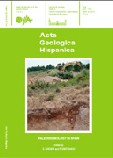Paleo and historical seismicity in Mallorca (Baleares, Spain): a preliminary approach
Abstract
The island of Mallorca is subject to low seismic activity. The instrumental record shows that current seismicity is surficial (<10 km depth) and low in magnitude (mb<4). Both historical and geological records display the occurrence of strong events, e.g. the 1851 Palma earthquake (VIII, MSK intensity). Data on this destruct ive event indicate that this was a seven month long seismic sequence, with two strong events, causing severe damage and collapse of buildings along Palma bay in addition to moderate ground collapses in the macroseismal zone. The earthquake epicenter was situated between Sa Cabaneta and Sta. Eugènia. This earthquake can be correlated with the trace of the Sencelles fault, the main extensional structure of the island on the surface. The geological and geophysical analyses of recent surface faulting features at the Portol doline (reverse surface faulting) and on the Sta. Eugènia segment of the Sencelles fault (bedrock fault scarp ) suggest recurrent large prehistoric events. Preliminary data show minimum vertical offsets of 2.56 m at the Portol doline and offsets of 3.50m at the Sta. Eugènia bedrock fault scarp. These offsets were accumulated in recent times (Holocene?). Displacements per event can be initially estimated as mean values of 0.88 to 0.40 m in both places, but larger offsets of a maximum of 1.68 m can also be inferred. Specific dendrochronologic, lichenometric, and weathering analyses to assess true single-event slip values, and their time-bracketing will be necessary. The interpretation of these displacement events in terms of earthquake magnitude is not straightforward because of the apparent subordinate nature of the ground rupture at the Po rtol doline and the possible influence of salt tectonics in both places. To address these issues, a fault-trench was planned along the Sencelles fault within the framework of a new research project. The Spanish seismic code (NCS94) assigns an expected maximum ground acceleration of 0.04 g for a 500 year return period to the area. In the light of our data these values are underestimated. The historical and geological records indicate the occurrence of historical VII to VIII MSK, and stronger prehistoric events. Peak ground horizontal accelerations of up to 0.10 g could be expected during modern earthquakes .


